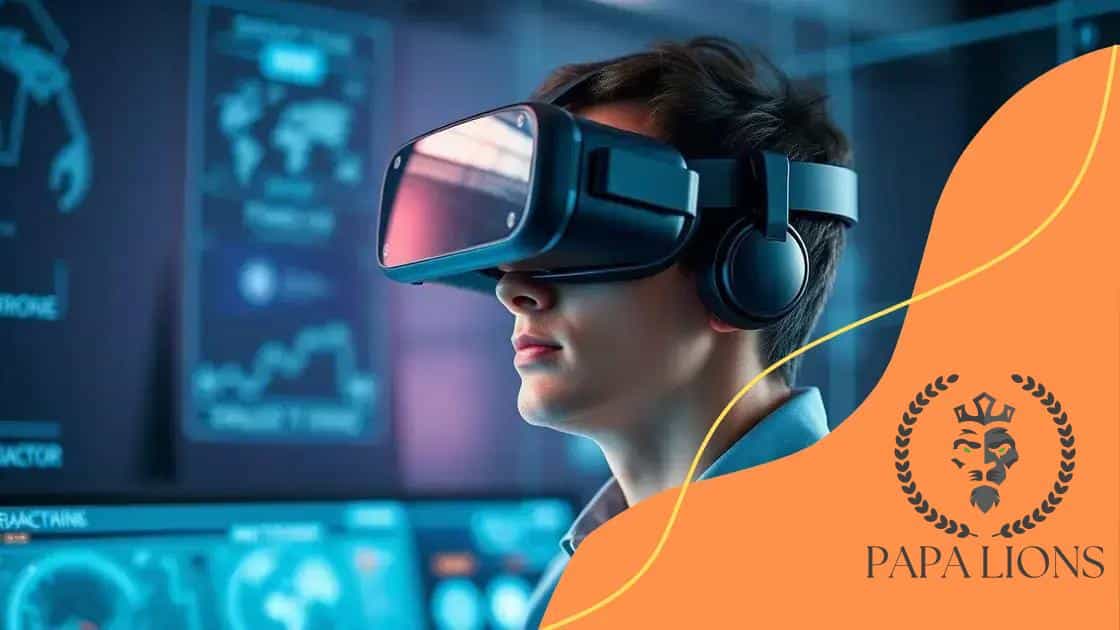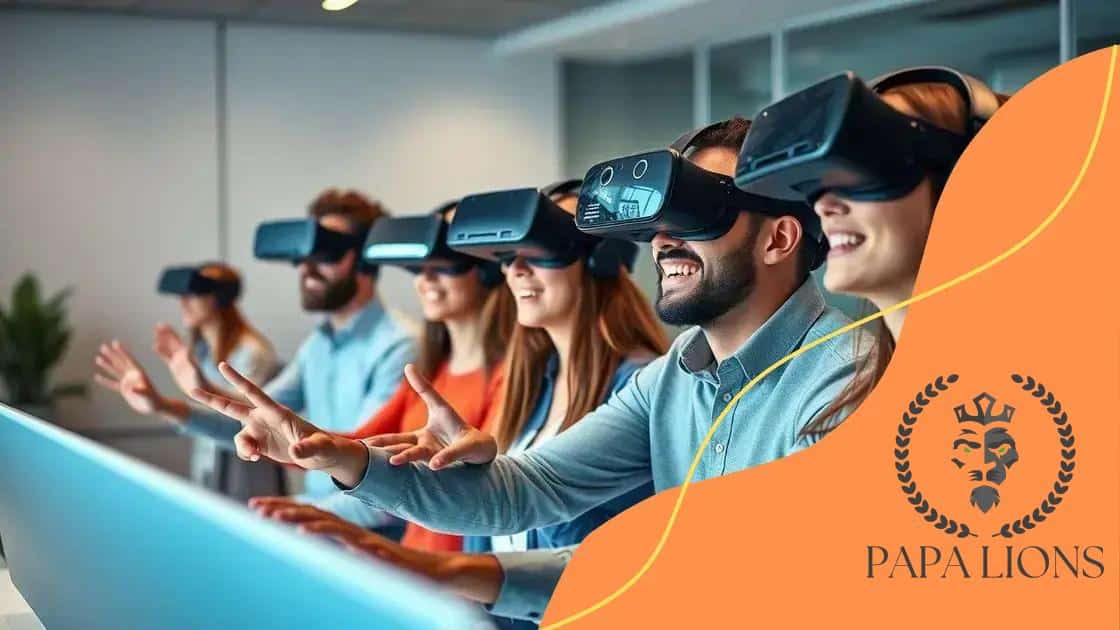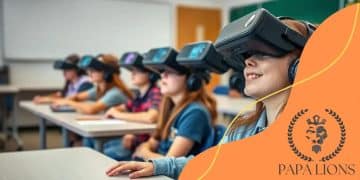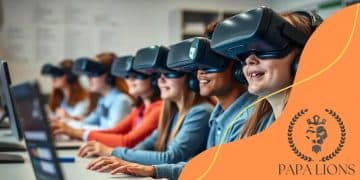Virtual reality for immersive training programs

Virtual reality enhances training programs by providing immersive, engaging experiences that improve skill retention and prepare employees for real-world challenges across various industries.
Virtual reality for immersive training programs is changing the way we learn and develop skills. Have you ever imagined stepping into a virtual world to enhance your training experience? In this article, we’ll dive into how VR can revolutionize training.
Understanding virtual reality technology
Understanding virtual reality technology is essential to grasp how it enhances training programs. At its core, virtual reality (VR) immerses users in a simulated environment, making experiences feel real. This technology can be used for various applications, particularly in training scenarios where skill development is crucial.
The foundation of VR is built on three main components: hardware, software, and content. The hardware typically includes a headset and motion sensors, which together create an engaging experience. Meanwhile, software drives the interaction within this virtual world, enabling users to engage with their surroundings.
Key Components of VR Technology
To further understand VR, it’s helpful to break down its key components:
- Headsets: Devices that allow users to enter virtual environments and experience immersive interactions.
- Motion Tracking: Technology that tracks users’ movements, allowing for responsive actions within the VR space.
- Content Creation: The process of developing virtual environments, scenarios, and interactions tailored for training.
As you explore virtual reality, consider the role of interactivity. Unlike traditional training methods, VR offers a unique opportunity for learners to practice in a risk-free environment. This interactivity enhances engagement, leading to better knowledge retention.
Moreover, VR technology has advanced significantly, making it more accessible to organizations of all sizes. With decreasing costs and increased availability of high-quality VR systems, companies are eager to adopt this innovation. As a result, organizations can train employees using realistic simulations that represent real-world scenarios.
In summary, virtual reality is a powerful tool that can transform training programs. By understanding its core principles and advantages, businesses can harness its potential to create immersive learning experiences.
Benefits of immersive training programs
Benefits of immersive training programs are numerous and impactful. These programs utilize virtual reality to create an engaging learning environment. By simulating real-world scenarios, employees can practice skills safely and effectively.
One of the primary advantages is enhanced engagement. Learners are more likely to pay attention and retain information when they are fully immersed in a training scenario. Virtual reality captures users’ focus, making the learning experience memorable.
Key Advantages of Immersive Training
Immersive training programs offer several key benefits:
- Realistic Simulations: Trainees can face realistic situations that mirror challenges in their jobs.
- Immediate Feedback: Participants receive feedback in real time, allowing for quicker adjustments and improvements.
- Safe Learning Environment: Mistakes made during training do not have real-world consequences, encouraging experimentation.
Additionally, these programs foster collaboration among employees. Participants can engage in group training sessions, sharing experiences and learning from each other. This collaborative approach creates a stronger learning community.
The accessibility of immersive training solutions is also a significant benefit. Organizations can train large groups without the need for extensive resources or travel. This convenience allows for greater flexibility in scheduling and participation.
Cost-effectiveness is another compelling aspect. Although there may be initial investments in technology, the long-term savings in training costs, reduced errors, and improved performance can be substantial. Companies often see a return on investment as employees become more competent and confident.
How companies are using VR for training

How companies are using VR for training showcases the innovative ways organizations are enhancing employee development. Many businesses are embracing virtual reality to create engaging and effective training programs.
For instance, in the healthcare sector, VR allows medical professionals to practice surgeries in a risk-free environment. Surgeons can rehearse complex procedures with realistic simulations, improving their skills without the pressure of a live patient.
Applications of VR in Various Industries
Different industries utilize VR training in their unique ways:
- Retail: Employees can experience customer interactions in virtual stores, helping them develop service skills.
- Aerospace: Pilots use VR to practice navigating aircraft, enabling them to handle emergency scenarios safely.
- Manufacturing: Workers can learn to operate machinery through immersive training, reducing the chance of accidents.
Moreover, companies are leveraging VR for soft skills development. Virtual reality allows employees to engage in scenarios that require teamwork, leadership, and communication skills. This immersive approach enhances learning and helps employees build confidence in their abilities.
Organizations are discovering that using VR for training can significantly cut costs. Traditional training methods may involve travel and extensive resources, but VR offers a more efficient and cost-effective solution. Employees can train at their convenience, leading to better productivity and reduced downtime.
As companies continue to explore this technology, the potential for VR in workplace training is expanding. Many are finding that it not only improves skills but also boosts employee satisfaction and engagement.
Challenges in implementing VR training
Challenges in implementing VR training can impact the effectiveness of these programs. While many benefits exist, understanding the hurdles can help organizations prepare better for deployment. One major challenge is the cost associated with VR technology. Initial investments in hardware, software, and content creation can be substantial, making it a challenging decision for some businesses.
Another obstacle is technical issues related to integrating VR into existing training systems. Sometimes, businesses face hiccups in software compatibility or hardware malfunctions that can hinder training delivery. This can lead to frustration among employees and disrupt the learning process.
User Experience and Comfort
The user experience in VR is critical. Some individuals may experience discomfort or motion sickness while using VR headsets, which could limit the training effectiveness. Ensuring that all participants feel comfortable is key to a successful implementation.
- Training and Support: Companies need to provide adequate training for employees on how to use VR systems effectively.
- Content Quality: High-quality content is necessary to keep learners engaged and achieve desired outcomes.
- Accessibility: Ensuring all employees have access to VR technology can be a challenge, especially in larger organizations.
Additionally, measuring the effectiveness of VR training can be complicated. Organizations may struggle to assess the learning outcomes compared to traditional training methods. Establishing metrics that accurately reflect VR training’s impact requires careful planning.
Despite these challenges, addressing them can lead to successful VR training programs. By recognizing the obstacles upfront, organizations can develop strategies to mitigate risks and improve user experiences.
The future of virtual reality in education and training
The future of virtual reality in education and training looks promising as technology advances. With continuous improvements in VR hardware and software, the potential applications are expanding rapidly. Educators and trainers are beginning to realize the power of immersive experiences to enhance learning.
As VR technology becomes more accessible, schools and organizations are increasingly incorporating it into their curricula. Students can explore complex subjects in ways that were previously unimaginable. For example, virtual field trips allow learners to visit historical sites or outer space without leaving their classrooms.
Innovations Shaping VR in Education
Several innovations are driving the future of VR in education:
- Adaptive Learning: VR can tailor educational experiences to the individual needs of students, providing customized learning pathways.
- Collaborative Experiences: Students can work together in virtual environments, promoting teamwork and communication skills as they solve problems.
- Gamification: Incorporating game-like elements into VR learning increases motivation and engagement, making education more enjoyable.
Moreover, the use of analytics in VR platforms can help educators track student progress in real time. By understanding how students interact with the material, teachers can make informed adjustments to improve learning outcomes.
The future also holds the promise of VR becoming a standard training tool in various industries. Companies are likely to invest in developing specialized training modules tailored to their needs. This shift will help create a more skilled workforce prepared to handle complex challenges.
As we look ahead, it is clear that VR will continue to transform education and training. By enhancing engagement and providing unique learning opportunities, virtual reality can play a pivotal role in shaping the future of how we learn and develop skills.
FAQ – Frequently Asked Questions about Virtual Reality in Education and Training
What are the main benefits of using virtual reality in training programs?
Virtual reality enhances engagement, provides realistic simulations, and allows for safe practice without real-world consequences.
How is virtual reality creating opportunities for students?
VR enables students to explore complex subjects through interactive experiences, such as virtual field trips and immersive learning environments.
What challenges do companies face in implementing VR training?
Challenges include high initial costs, technical issues, user comfort concerns, and measuring training effectiveness.
How does VR prepare employees for the workforce of the future?
By providing hands-on, immersive experiences, VR helps employees develop skills that are relevant to the evolving needs of industries.





